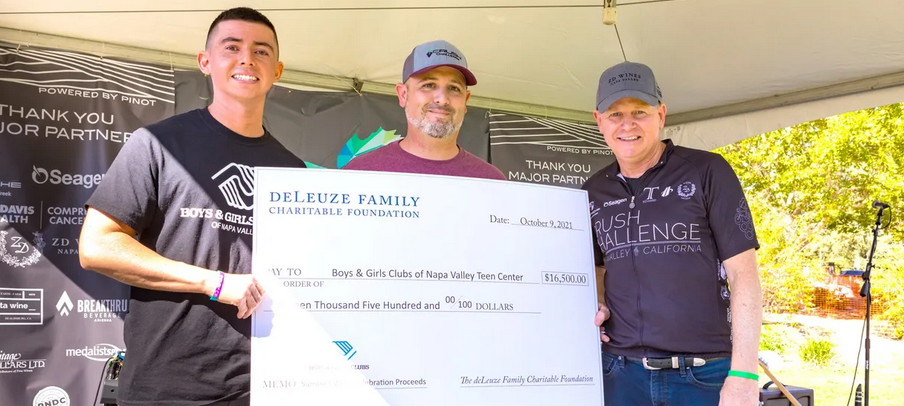
St. Supéry Chronicles | July 2019
2019 Vineyard Update

July heats up, both from a weather and intensity perspective. The work required annually to ensure we are growing the highest quality grapes is a herculean effort. We recently completed wire positioning, a tactical process that guides the canopy upright to optimize sun exposure, to create the correct balance of shade for the fruit. This practice also provides the canes extra support for the weight of the grapes.
With the shoots vertical, we remove some leaves allowing airflow and sunlight to penetrate the inner parts of the canopy to make its way to the berries without over exposure to the sun. In July, we are also in the early stages of fruit thinning, a practice that involves removing under developed fruit clusters to achieve balance. This provides the vine and clusters sufficient space and energy to ripen. By removing the under developed fruit, the vine can focus on photosynthetic energy, ripening the best clusters.
July started off with mild temperatures, trending a little below average. Mother Nature turned up the heat for the remainder of the month with numerous days over 90 degrees. The heat spikes encouraged the onset of veraison at our Dollarhide and Rutherford Estate Vineyards, signaling that the 2019 harvest is on the horizon.
So what exactly is verasion?
Veraison is the process when red grape varieties change from green to purple and then to deep dark purple. White grape varieties change from green to golden yellow, becoming almost translucent as full ripeness is reached. During veraison, the grapevine shifts attention from growth to ripening. Now focusing its energy on increasing the sugar (brix) in the grape which will lead to full ripeness and develop the flavor characteristics found in a wine.
Cheers to a successful 2019 harvest season!

Peppers are Abundant in our Culinary Garden
At St. Supéry, we love growing and cooking with spicy peppers. The spiciness, common in Thai and Asian dishes, pairs wonderfully with our Napa Valley Estate Moscato. National Hot and Spicy Food Day is August 19th. We caught up with our Estate Horticulture Manager, Bri, and asked her some questions about all things related to spicy peppers!
Do you have any exciting pepper varieties that you are growing this year in the St. Supéry culinary garden?
Yes, many! We have just over 50 different varieties, some of which are sweet and others that are hot. On the hot side, we have the hottest edible pepper, the Carolina Reaper. Trinidad Scorpion and Ghost Peppers that are up there on the Scoville heat scale. Some really cool hot varieties we have are Black Hungarian, Sriracha, Tabasco, Fish (which produce a white pepper before turning red). We are also growing Scotch Bonnets, Thai Dragons, Orange, Lemon and Pumpkin Spice Jalapeños. Of course, some classics like Habaneros, Padrons and Serranos.
Do you have any tips for ensuring a heavy pepper harvest?
Choose a site that receives full sun and has well-draining soil. Peppers like as much sun as they can get and they don’t like their roots to be waterlogged. Prior to planting your peppers, apply a good compost. This will ensure a steady supply of nutrients for the pepper plants. Also, place a few matches in the hole because pepper plants love sulfur.
To allow the plant to establish its root system and grow stronger to produce more peppers later, pinch off any flowers for the first couple weeks, sacrificing a few early peppers will have positive effects later in the summer.
If adding fertilizer, wait a few weeks after planting to apply, otherwise you may get too much vegetative growth and less fruit production. Use a 5-10-10 fertilizer or any that has half as much nitrogen than phosphorous and potassium to encourage higher yields.
How much water do peppers need?
Typically peppers thrive with about 1-2 inches of water per week, if it is really hot give them a little more. If the peppers are planted directly in the ground, just apply the water about once per week instead of breaking it up into smaller waterings. For peppers growing in a container, the frequency of watering will be more than once a week, it is important to never let the soil go completely dry. When hand watering, make sure to give the water directly above the soil line and try not get the leaves wet.
How do you know when the peppers are ready to harvest?
When to harvest peppers really depends on the variety. Some varieties, such as Shishito or Padron, are ready when they reach their desired size. They will eventually turn red, but are best when smaller and green. There are some varieties like Jalapeños and Poblanos that are typically picked while still green. You know they’re ready when the shade of green becomes darker. As a general rule, peppers are ready to be picked when the stem becomes more brittle and easily breaks away from the plant. Like your peppers spicy? Leave them on the vine a little longer, they will develop more spice as they age.
Try These Great Pepper Recipes at your Next Barbecue!












